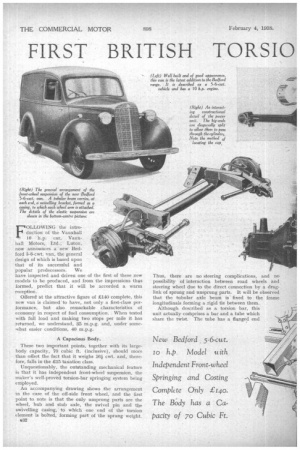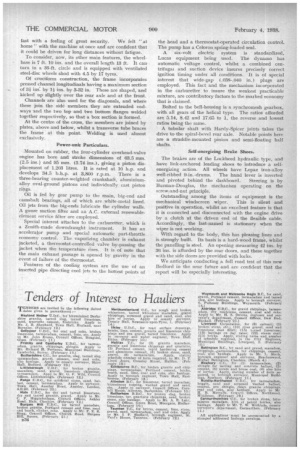FIRST BRITISH TORSIO BAR-SUSPENDED VAN
Page 20

Page 21

Page 22

If you've noticed an error in this article please click here to report it so we can fix it.
FOLLOWING the introduction of the Vauxhall . 10 h.p. car, Vauxhall Motors, Ltd., Luton, now announces a new Bedford 5-6-cwt. van, the general design of which is based upon that of its successful and popular predecessors. We have inspected and driven one of the first of these new models to be produced, and from the impressions this formed, predict that it will be accorded a warm reception.
Offered at the attractive figure of £140 complete, this new van is claimed to have, not only, a first-class performance, but also remarkable characteristics of economy in respect of fuel consumption. When tested with full load and making two stops per mile it has returned, we understand, 35 m.p.g. and, under somewhat easier conditions, 40 ni.p.g.
A Capacious Body.
These two important points, together with its largebody capacity, 70 cubic ft. (inclusive), should more than offset the fact that it weighs 16i cwt. and, therefore, falls in the £15 taxation class.
Unquestionably, the outstanding mechanical feature is that it has independent front-wheel suspension, the maker's well-proved torsion-bar springing system being employed.
An accompanying drawing shows the arrangement in the case of the off-side front wheel, and the first point to note is that the only unsprung parts are the wheel, hub and stub axle, the swivel pin and the swivelling casing, ' to which one end of the torsion element is bolted, forming part of the sprung weight. 832
Thus, there are no steering complications, and no possibility of interaction between road wheels and steering wheel due to the direct connection by a drag link of sprung and unsprung parts. It will be observed that the tubular axle beam is fixed to the frame iongitudinals forming a rigid tie between them.
Although described as a torsion bar, this unit actually comprises a bar and a tube which share the twist. The tube has a flanged end bolted to the main casing, and encloses the bar for most of its length. One end of the inner member is splined to the tube and the other to the wheel arm. The lastnamed carries an extension, forming a short sleeve on the bar, and this is mounted in two needle-roller bearings, whilst, where it protrudes from the casing, it passes through an oil-retaining gland.
Splined to this sleeve within the casing is an arm bearing against a short stiff compression spring, with which it forms a type of toggle. The spring is mounted between knife edges, one at each end. There is also a simple hydraulic damping device, and the whole enclosed gear works in shock absorber oil.
Under normal load, the toggle members are in line, so the compression spring has no influence on the torsion unit. The least upward (or downward) movement of the wheel arm, however, brings the coiled spring into action, and its effect is to tend to twist the torsion bar in the same direction as the arm is twisting it. Thus, the resistance offered equals the difference between the turning moment exerted by the spring and the reactionary torque of the bar.
Progressive Spring Action.
As the movement increases, the compression spring expands and its pressure diminishes. In this way the effective resistance of the system increases with displacement, and progressive springing is afforded. The suspension system is self-adjusting to load and other conditions, whilst bouncing on rough surfaces and rolling on corners are minimized.
Flexible semi-elliptic underslung springs, with Silentbloc bushings and controlled by separate Lovejoy hydraulic shock absorbers, are used at the rear, and the combination appears to function admirably.
Our experience on the road showed that not only does the machine ride well over bad surfaces, but also that it steers splendidly. The steering is light and positive, self-centring and accurate, and corners can be taken fast with a feeling of great security. We felt " at home " with the machine at once and are confident that it could be driven for long distances without fatigue.
To consider, now, its other main features, the wheelbase is 7 ft. 10 ins, and the overall length 13 ft. It can turn in a 35-ft. circle and is equipped with ventilated steel-disc wheels shod with 4.5 by 17 tyres.
Of cruciform construction, the frame incorporates pressed channel longitudinals having a maximum section of 3iins by 11 ins. by 3-32 in. These are shaped, and kicked up slightly over the rear axle and at the front.
Channels are also used for the diagonals, and where these join the side members they are extended endways and the two top and two bottom flanges welded together respectively, so that a box section is formed.
At the centre of the cross, the members are joined by plates, above and below, whilst a transverse tube braces the frame at this point. Welding is used almost exclusively.
Power-unit Particulars.
.Mounted on rubber, the four-cylinder overhead-valve engine has bore and stroke dimensions of 61.5 mm. (2.5 ins.) and 95 mm. (3.74 ins.), giving a piston displacement of 1.203 litres. It is rated at 10 h.p. and develops 34.5 b.h.p. at 3,800 r.p.m. There is a three-bearing counter-weighted crankshaft, aluminiumalloy oval-ground pistons and individually cast piston rings.
Oil is fed by gear pump to the Main, big-end and camshaft bearings, all of which are white-metal lined. Oil jets from the big-ends lubricate the cylinder walls. A gauze suction filter and an A.C. external renewableelement service filter are employed.
• Special interest attaches to the carburetter, which is a Zenith-made • downdraught instrument. It has an accelerator pump and special automatic part-throttle economy control. The vaporizing chamber is exhaust jacketed, a thermostat-controlled valve by-passing the jacket when the temperature rises. It is of note that the main exhaust passage is opened by gravity in the event of failure of the thermostat.
Features of the cooling system are the use of an inserted pipe directing cool jets to the hottest points of the head and a thermostat-operated circulation control_ The pump has a Celoron spring-loaded seal.
A six-volt electric system is standardized, Lucas equipment being used. The dynamo has automatic voltage control, whilst a combined centrifugal and suction device insures precisely correct ignition timing under all conditions. It is of special interest that wide-gap (.038-.040 in.) plugs are employed. This fact and the mechanism incorporated in the carburetter to insure the weakest practicable mixture, are contributory factors to the marked economy that is claimed.
Bolted to the bell-housing is a synchromesh gearbox, with all gears of the helical type. The ratios afforded are 5.14, 8.42 and 17.65 to 1, the reverse and lowest ratios being the same.
A tubular shaft with Hardy-Spicer joints takes the drive to the spiral-bevel rear axle. Notable points here are a straddle-mounted pinion and semi-floating half shafts.
Self-energizing Brake Shoes.
The brakes are of the Lockheed hydraulic type, and have link-anchored leading shoes to introduce a selfenergizing action. All wheels have Lepaz iron-alloy
well-ribbed 9-in.-drums. The hand lever is inverted and pivoted behind the dashboard. Steering is by Burman-Douglas, the mechanism operating on the screw7and-nut principle.
Outstanding among the items of equipment is the mechanical windscreen wiper. This is silent and positive in operation, whilst an excellent feature is that it is connected and disconnected with the engine drive by a clutch at the driven end of the flexible cable. Accordingly, the last-named is stationary when the wiper is not working.
With regard to the body, this has pleasing lines and is strongly built. Its basis is a hard-wood frame, whilst the panelling is steel. An opening measuring 42 ins. by 36 ins, is afforded by the rear doors, and these together with the side doors are provided with locks.
We anticipate conducting a full road test of this new Bedford in the near future and are confident that the report will be especially interesting. •


































